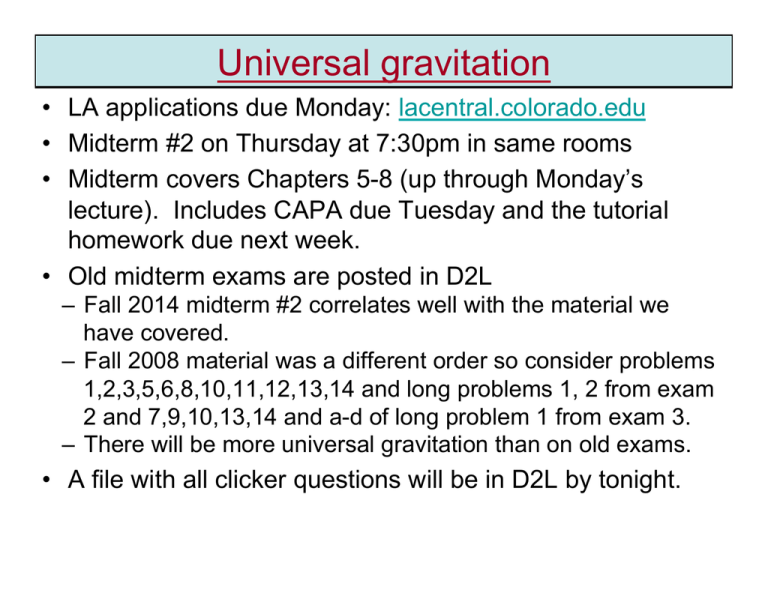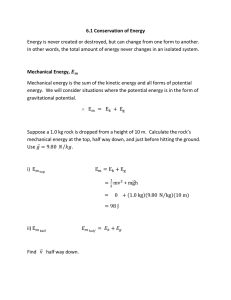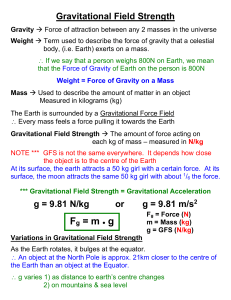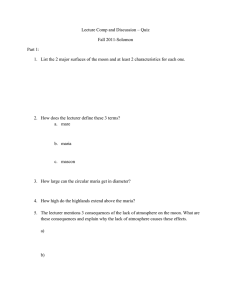Universal gravitation - University of Colorado Boulder
advertisement

Universal gravitation • LA applications due Monday: lacentral.colorado.edu • Midterm #2 on Thursday at 7:30pm in same rooms • Midterm covers Chapters 5-8 (up through Monday’s lecture). Includes CAPA due Tuesday and the tutorial homework due next week. • Old midterm exams are posted in D2L – Fall 2014 midterm #2 correlates well with the material we have covered. – Fall 2008 material was a different order so consider problems 1,2,3,5,6,8,10,11,12,13,14 and long problems 1, 2 from exam 2 and 7,9,10,13,14 and a-d of long problem 1 from exam 3. – There will be more universal gravitation than on old exams. • A file with all clicker questions will be in D2L by tonight. 1 Force of gravity on Earth Gm1m2 F = mg How does g correspond to our new force FG = ? 2 r If we consider mass 2 to be the Earth (ME) and r to be the radius of the Earth (RE) then we can write F = m GM E G 1 RE2 Using known values we can find that −11 2 2 24 6.67 ×10 N ⋅ m / kg 5.97 ×10 kg GM E 2 = = 9.8 m/s 2 6 RE2 6.38 ×10 m ( )( ( ) ) So, on the surface of the Earth, the force of GM E F = m = m1g 1 gravity between the Earth and an object m1 is G 2 R E We can only use Fg = mg if the distance above the 2 surface is very small compared to the radius. Clicker question 1 Set frequency to BA Two asteroids in inter-galactic space are a distance r = 20 km apart. Asteroid 2 has 10 times the mass of asteroid 1. The magnitudes of the forces on asteroids 1 and 2 are F1 and F2, respectively. What is the ratio F1/F2? r = 20 km Gm1m2 FG = A. 1/100 m1 m2 r2 B. 1/10 m2 = 10m1 C. 1 D. 10 The force on m1 is the Gm1m2 same as the force on m2: FG = r 2 E. 100 This is also a consequence of Newton’s 3rd law. 3 Clicker question 2 Set frequency to BA Two asteroids in inter-galactic space are a distance r = 20 km apart. Asteroid 2 has 10 times the mass of asteroid 1. The magnitudes of the accelerations of asteroids 1 and 2 are a1 and a2, respectively. What is the ratio a1/a2? A. 1/100 B. 1/10 C. 1 D. 10 E. 100 FG = Gm1m2 r2 r = 20 km m1 m2 m2 = 10m1 The force on m1 is the Gm1m2 same as the force on m2: FG = r 2 F Acceleration is force divided by mass a = m so FG FG a1 FG m2 m2 and a2 = a1 = = ⋅ = = 10 which gives us m2 m1 a2 m1 FG m1 4 Clicker question 3 Set frequency to BA A rock is released from rest in space beyond the orbit of the Moon. The rock falls toward the Earth and crosses the orbit of the Moon. At this point, the acceleration of the rock is… A. greater B. smaller C. the same as the acceleration of the Moon. You can ignore the force between Moon and rock. Moon Earth rock Gm1m2 FG = r2 If the Moon and the rock are a distance r from the center of the Earth then the acceleration of either mass can be determined by F 1 GM E m GM E independent of whether it is the a= = = 2 2 Moon or a rock m m r r Note, the velocity directions and magnitudes may not be the same but the accelerations are the same! 5 Gravitational potential energy When we used Fg = mg we found a potential energy of U g = mgy . Gm1m2 What is the potential energy associated with the force FG = ? 2 r To make sense, potential energy should increase as the distance increases and be smallest when the objects are closest together. We recently learned that force is the derivative of potential energy. Gm1m2 Gm1m2 gives the force FG = r2 r when you take the derivative with respect to r. The potential energy UG = − 6 Gravitational potential energy Potential energy increases (less negative) as the separation increases. This is what we wanted. UG = − Gm1m2 → 0 as r → ∞ r Gm1m2 UG = − → − ∞ as r → 0 r Maximum potential energy is 0 when r approaches infinity. Since two objects cannot share the same space, r > 0. The minimum potential energy is when the objects are touching. 7 Earth’s gravitational potential energy Potential energy due to Earth’s gravity is Gm1mE Gm1mE UG = − =− r RE + h where r is the distance from the center of the Earth and h is the height above the surface of the Earth. K UG + K UG RE = radius of Earth = 6380 km Distance from center of the Earth (km) Suppose a rock is released from rest at r = 30000 km. Initially it only has potential energy. It will start falling, converting potential energy to kinetic energy. The total energy (UG+K) stays the same. The rock cannot go past r = 30000 km because it would have negative kinetic energy at that point (which is impossible). 8 Effect of total energy on trajectory If the total energy is ≥ 0 then it is possible for the object to make it to r = ∞. We can identify three basic scenarios for a total energy (UG + K ) which is positive, negative, or 0. UG + K K UG RE = radius of Earth = 6380 km Distance from center of the Earth (km) For total energy < 0 the object is bound by the gravitational field (and orbits are ellipses). Examples are planets around the sun. For total energy of 0 the object is barely unbound (parabolic orbit). For total energy > 0, object is unbound with a hyperbolic orbit. 9





